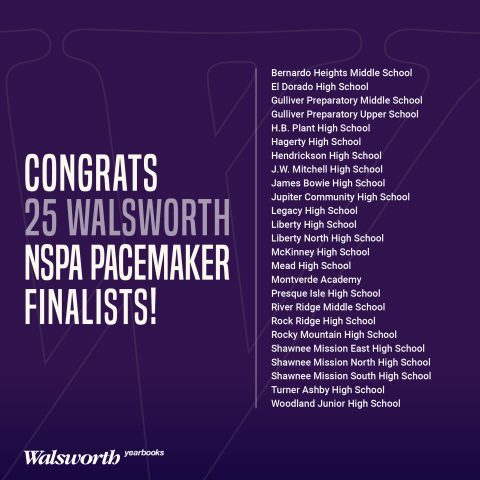That first deadline can be one of the most intimidating parts of an adviser’s first year. Follow this advice, including words of wisdom from a few experienced advisers, to successfully meet it.
Make it a priority
Take deadlines seriously – especially this first one. Start planning right away, if you have not already begun. Talk to your rep about exactly what you need to submit.
Make sure your staff knows what is expected of them and lay out a plan to meet the deadline. Inform them of the penalty for missing a deadline.
Follow the ladder
Sticking to the ladder will make your entire year easier. The ladder is a detailed map of the plan for every page. Include primary and secondary coverage in your ladder. Without this guide, you risk missing deadlines and coverage.
And a reminder: the ladder can change. Deadlines don’t. The ladder is a living document and can be adjusted as coverage needs change during the year.
Set mini-deadlines
Know the limits of your staff and the scope of material they are gathering. Know how long you have before pages are due. Space out the work evenly. It won’t seem so daunting if you accomplish the work piece by piece. Mini-deadlines lead up to the big deadline.
“Set as many tiny deadlines as you possibly can. Deadlines for plans, deadlines for pictures, deadlines for spreads,” said Tiffany Kopcak, adviser at Colonial Forge High School in Stafford, Virginia. “Use deadlines as your way to teach students time management and problem solving.”
Kopcak recommends being flexible with what is due, while ensuring your staff is making continued progress.
Have students create a daily task chart, Elizabeth Luna, adviser at Athens Drive High School in Raleigh, North Carolina, said. This proves they are completing each task, which Luna said is especially important for the first deadline, “as students are not usually the best time managers.”
Post staff deadlines everywhere: on bulletin boards around the classroom, on Google Docs and on social media. Every staff member will be well aware of how much time they have.
For Online Design users, the adviser and editors can monitor mini-deadlines by checking page progress within the program.
Meet regularly with individuals and teams. Have editors and staff members hold each other accountable and document progress, and the first big deadline won’t seem so daunting.
Don’t be naïve
Something is bound to go wrong. It could be computer error, human error or something outside anyone’s control – like a massive flu outbreak at the school. Prepare as much as possible now. If you don’t expect smooth sailing, the choppy waves won’t throw you overboard.
Lie to your staff (a little)
“Never tell the staff what the plant deadline is,” Kopcak said.
You know the absolute last moment you can turn in your pages, but your staff doesn’t. Keep it that way.
Luna suggests you “set your students’ deadlines one to two weeks earlier than your publishing deadline.”
Don’t give away your secret. If they find out they had extra time at the first deadline, they might be tempted to cut it close the rest of the year.
Set priorities
It’s tempting to focus on the fun parts of yearbook, while putting off the rest. Many staffers would rather spend time looking through all the images instead of writing stories or designing spreads. Set up the fun parts as rewards once the less-desirable tasks are complete.
Use available resources
Lori Mortland, adviser at Calhoun High School in Hardin, Illinois, said the use of templates was “life-changing” for her staffs.
“Taking the time to set a template will eliminate many small issues that could drive a person crazy as deadlines approach,” Mortland said.
Technology can make your life easier in other ways. If a staff member can’t make it to an important meeting, use video phone call technology to bring them in. Some programs even offer a screen-sharing option.
Jonathan Bickel, adviser at Eastern Lebanon County High School in Myerstown, Pennsylvania, suggested visiting another school. “One of the best things a new adviser can do is visit a veteran adviser’s classroom and find out what works for them,” he said.
Don’t get tunnel vision
Just because you’re focused on the first deadline doesn’t mean you can’t work on future deadlines.
Bickel said the entire yearbook is organized by deadline on a white board in the classroom.
“Each spread is assigned to two class members,” Bickel said. “We always assign spreads two deadlines in advance. Deadline dates are posted at the beginning of the year so students do not have excuses for not making them. These things help the production flow smoothly.”
Crystal Kazmierski, former adviser at Arrowhead Christian Academy in Redlands, California, typically worked on several deadlines at once.
“Don’t just focus on the first deadline and then have nothing going for the next,” Kazmierski said. “Get as much done up front as you can, even if it is in a future deadline. It will keep you ahead of the game and make life a lot easier. Plus, the advanced progress feels great!”
Dole out the rewards
Praise staff members when they meet a mini-deadline. Celebrate once the big one is met. These hard-working students will appreciate the recognition. Pizza parties are popular in the yearbook world. You could use this tried-and-true reward, or come up with something unique to your staff.





